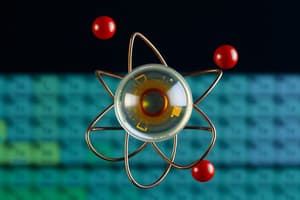Podcast
Questions and Answers
What is the atomic number of carbon?
What is the atomic number of carbon?
- 5
- 12.0107
- 7
- 6 (correct)
Which of the following statements is true about elements?
Which of the following statements is true about elements?
- Each element has a unique atomic mass. (correct)
- All elements have the same atomic number.
- Gold can be divided into other substances.
- Elements can be broken down into simpler substances.
What do you call two or more elements combined together?
What do you call two or more elements combined together?
- Molecules
- Compounds (correct)
- Ions
- Atoms
In terms of the periodic table, what information is represented by the element's 'address'?
In terms of the periodic table, what information is represented by the element's 'address'?
Which group and period does Boron (B) occupy on the periodic table?
Which group and period does Boron (B) occupy on the periodic table?
Which type of element shares properties with both metals and nonmetals?
Which type of element shares properties with both metals and nonmetals?
What does the atomic mass of an element represent?
What does the atomic mass of an element represent?
How are elements in the periodic table arranged?
How are elements in the periodic table arranged?
How many groups are present in the periodic table?
How many groups are present in the periodic table?
What is the relationship between elements in the same group of the periodic table?
What is the relationship between elements in the same group of the periodic table?
Flashcards
Elements
Elements
Substances that cannot be broken down into simpler substances.
Element Symbol
Element Symbol
A unique symbol assigned to each element.
Atomic Number
Atomic Number
The number of protons in the nucleus of an atom. It determines the element's identity.
Atomic Mass
Atomic Mass
Signup and view all the flashcards
Periods
Periods
Signup and view all the flashcards
Groups
Groups
Signup and view all the flashcards
Metalloids
Metalloids
Signup and view all the flashcards
Metals
Metals
Signup and view all the flashcards
Nonmetals
Nonmetals
Signup and view all the flashcards
Periodic Table
Periodic Table
Signup and view all the flashcards
Study Notes
Elements and the Periodic Table
- Elements are substances that cannot be broken down into simpler substances.
- Examples include gold, which remains gold even when broken into smaller pieces.
- Over 100 elements are known.
- Each element has a unique name, symbol (shorthand), and atomic number.
- Atomic number orders elements across the periodic table.
- Element blocks provide atomic number, symbol, name, and atomic mass.
- Carbon (C) has the atomic number 6 and atomic mass 12.0107.
Periodic Table Structure
- The periodic table is organized into groups (vertical columns) and periods (horizontal rows).
- Each group and period defines a specific location for an element.
- Group numbers range from 1 to 18, and period numbers are 1 to 7.
- Example: Boron (B) is located in group 13, period 2.
Element Properties and the Periodic Table
- Elements within the same group share similar characteristics.
- The periodic table aids in identifying if an element is a metal, nonmetal, or metalloid.
- A staircase line separates metals (left side, excluding hydrogen) and nonmetals (right side).
- Metalloids are located along the staircase.
Studying That Suits You
Use AI to generate personalized quizzes and flashcards to suit your learning preferences.



